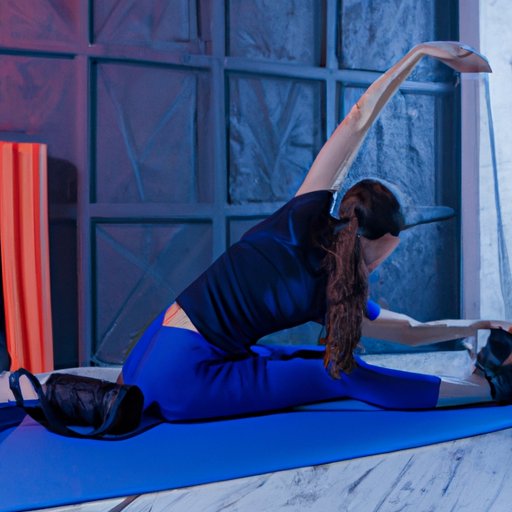Introduction
Being physically flexible is an important component of overall health and wellness. Flexibility is the ability of a joint or series of joints to move through an unrestricted, pain-free range of motion. It’s an essential part of maintaining muscle balance and preventing injury. Unfortunately, many people are naturally quite stiff and struggle to increase their flexibility.
If you’re feeling very stiff and want to become more flexible, there are plenty of ways to do so. This article provides a comprehensive guide on how to become more flexible if you’re very stiff. We’ll cover warm-ups, regular stretch breaks, yoga, resistance bands, foam rolling, and dynamic stretching. Read on to learn more about increasing your flexibility!
Start With a Warm-Up
Before engaging in any physical activity, it’s important to warm up first. Warming up helps to increase blood flow to your muscles, reduce the risk of injury, and improve performance. For those who are particularly stiff, warming up is even more important.
A good warm-up should include some light cardio, such as jogging or jumping jacks. You can also add in some dynamic stretches, which involve actively moving your body through a full range of motion. Examples include arm circles, leg swings, and trunk twists.
Take Regular Stretch Breaks
In addition to warming up before physical activity, it’s important to incorporate regular stretch breaks throughout the day. Taking frequent breaks to stretch can help to reduce tension in your muscles and increase your range of motion. It can also help to prevent injury and improve posture.
During your stretch breaks, focus on simple static stretches that target all major muscle groups. Examples include calf stretches, hamstring stretches, chest stretches, and shoulder stretches. Hold each stretch for at least 30 seconds to get the most benefit.
Try Yoga
Yoga is a great way to increase flexibility. It combines stretching with mindfulness and breath work, which can help to relax your muscles and increase your range of motion. There are many different types of yoga, so you can find one that fits your needs and preferences.
When practicing yoga, focus on your breath and take your time. Move slowly into each pose and stop if you feel any discomfort. You don’t need to push yourself too hard; just listen to your body and move within your own limits.
Use Resistance Bands
Resistance bands are a great tool for increasing flexibility. They provide resistance to your muscles as you move, which helps to increase your range of motion. Resistance bands come in different levels of resistance, so you can find one that’s suitable for your fitness level.
When using resistance bands to increase flexibility, focus on slow, controlled movements. Start with a light band and gradually work your way up to a heavier band as your flexibility improves. Be sure to keep proper form and avoid pushing yourself too hard.
Incorporate Foam Rolling
Foam rolling is another great way to increase flexibility. It involves rolling your body over a foam roller to release tension and break up knots in your muscles. This can help to reduce pain and stiffness, improve mobility, and increase your range of motion.
When foam rolling, use slow and gentle movements. Focus on areas that are especially tight or painful. Don’t roll too fast or press down too hard; just apply enough pressure to feel a mild stretch.
Practice Dynamic Stretching
Dynamic stretching is a type of stretching that involves active movement. It helps to improve range of motion by loosening up tight muscles and improving coordination. Examples of dynamic stretching exercises include walking lunges, high knees, and butt kicks.
When doing dynamic stretching, focus on slow, controlled movements. Make sure to keep proper form and avoid pushing yourself too hard. Start with shorter sets and gradually increase the duration as your flexibility improves.
Stick With It
Increasing flexibility takes time and consistency. To see results, you need to commit to a regular stretching routine and stick with it. Find something that works for you and make it a part of your daily routine.
To stay motivated, set small achievable goals and celebrate your progress. You can also try different activities and switch up your routine to keep things interesting. Remember, even small changes can make a big difference in the long run.
Conclusion
Increasing flexibility can seem like a daunting task, but it doesn’t have to be. With the right approach and some patience, you can become more flexible even if you’re very stiff. Start by incorporating warm-ups, regular stretch breaks, yoga, resistance bands, foam rolling, and dynamic stretching into your routine.
Remember, consistency is key. Stick with your routine and don’t give up.
(Note: Is this article not meeting your expectations? Do you have knowledge or insights to share? Unlock new opportunities and expand your reach by joining our authors team. Click Registration to join us and share your expertise with our readers.)
